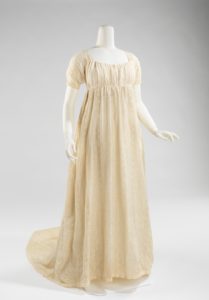A Stitch is Worth a Thousand Words, Part I: Recreating an Early 1800s Gown
Why Recreate Historical Garments?
Whenever I embark on recreating a historical garment, I remember why such recreation is important. As a historian, my mission is to research, understand, and present the past not as an abstract and irrelevant entity from “way back in ye days of olde,” but rather as a very real and almost tangible narrative of people who lived, breathed, and experienced life.
As a self-taught seamstress who uses historical sewing methods, extant garments, and other period notations to recreate clothing, I’ve learned that narratives of a cultural, political, and economic world can be found in stitches and in clothing. After all, what we wear is an expression not only of ourselves, but also of our world. This is a universal truth that is relevant today and yesterday.
And so, I endeavor to climb into another’s shoes through period clothing. It’s this mindset that carries me through my reproduction of an early 1800s Empire waist gown for an upcoming Material Culture Conversation titled, The Many Layers of a Lady. The conversation will focus on LancasterHistory’s collection items, as well as my historical reproduction gown, and highlight all the necessary layers of clothing that helped women achieve the popular silhouette of the time.
While you will see the finished project at the Material Culture Conversation, I invite you to join me now as I recreate this gown. Through a series of blog posts, I will highlight the historical stitches that will bring this gown to life.
So without further ado, let’s step into a portrait to understand how such a journey begins.
Measure Twice, Cut Once: Project Preparations
Before I get close to cutting into fabric, I dive into research. This includes sifting through period fashion plates, extant garments in museum collections, and historical pattern drafts.
Understanding the Fashion

The first step in this project is understanding the fashion trend of the time. This style of gown, which was fashionable from roughly 1795-1820, boasts a Neoclassical look. During this time in history, we see a Greco-Roman revival in architecture, fashion, and thought. This is the age that was born out of two revolutions in America and France, which were inspired, in part, by philosophical discussions of the Republic. Architecture of this time period features nods to Ancient Greece and Rome with its symmetrical balance and grand columns. In fashion, we see a free form silhouette similar to the robes of Ancient Greco-Roman culture. This revived silhouette highlights the natural form of the body in ways that the years before and after this period will not demonstrate.
The construction of the gown itself features a closely fitted bust with an Empire waist, or high waist that fell just below the bust. From that high waist, the skirt flowed freely along the body, having no structure underneath in the form of body-altering layers that traditionally would add fullness and shape (think about pocket hoops, bum rolls, or several layers of petticoats). These gowns would, on occasion, have trains of varying lengths, and would usually be accessorized with shawls that were reminiscent of the ancient togas.
Gathering the Evidence

My evidence starts with two specific LancasterHistory collection items: a 1798 green silk gown, and an 1817 portrait of Mrs. John Hoff in a green silk gown, painted by Jacob Eicholtz. Though the extant gown in our collection is not Mrs. Hoff’s gown, it bears a similar resemblance in color and construction and comes from the same time period. The two gowns also have enough variance to show different styles of the period, such as sleeve shape and length.
With these two gowns, I knew that I would be making a green silk gown, but I wanted to arm myself with more portraiture from which to study. And so, I went in search of fashion plates and other extant garments. Though I looked at many items, I will provide a small sampling of some additional research from other museums’ collections.
- The Met offers a wide collection of 1800s gowns that inspired my project. One is of a silk gown and another is of a cotton gown, both made in America.
- The Victoria & Albert museum has a lovely collections item of Empire gowns with varying sleeve lengths and accessories, which helped supplement how to complete the full look of this period.
Getting the Materials
Armed with history, I began gathering materials. I found green silk fabric (and white cotton muslin for the fabric lining) from Burnley & Trowbridge, a wonderful source for historical reproduction textiles and other notions for the 17th-19th centuries.
For the pattern, I chose Laughing Moon Mercantile’s Pattern #126, a historical pattern based on extant garment research.
Once everything came into place, I began cutting into the fabric and reconstructing the past. And so, I shall leave you with a cliff hanger of sorts. Care to see how I’m stitching this gown together with historical method? Tune in to my next post, coming to you shortly.
From History From The House